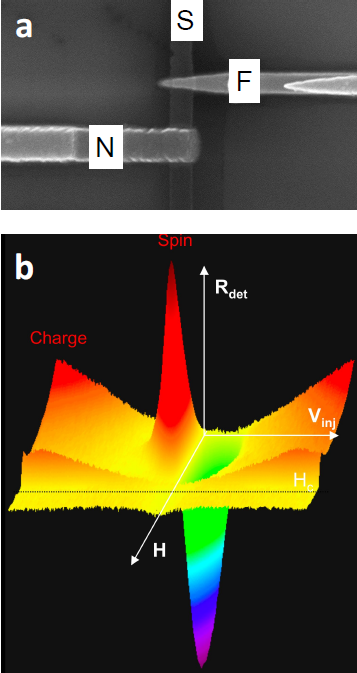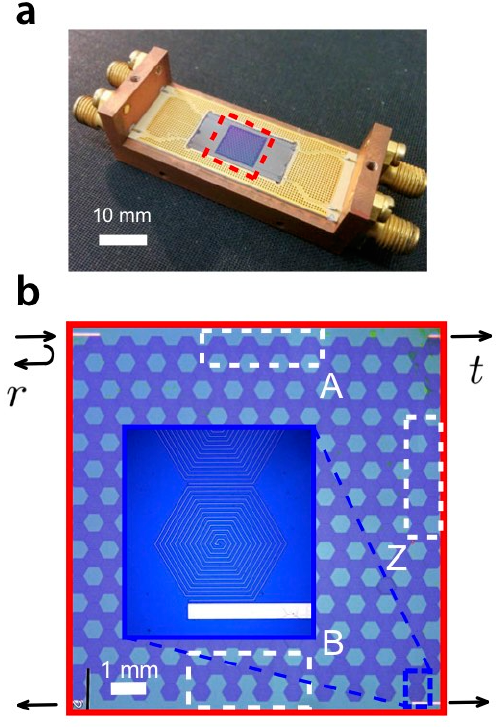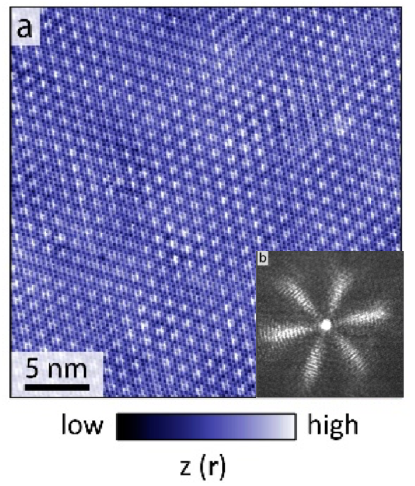We study electronic transport in quantum matter systems and especially the dynamics of such systems. Below you can find the projects we are currently working on. If you are interested in joining any of these projects as an intern, PhD or postdoc, please don’t hesitate to contact the indicated contact person(s).
Mesoscopic Superconductivity and
Superconducting Spintronics

The ground state of conventional superconductors is made up of pairs of electrons. For each pair the spins of the electrons are anti-aligned with no preferential spin axis. We study spin physics in mesoscopic superconductors at equilibrium and out-of-equilibrium. We explore unconventional ground-states including equal spin triplet paring in 2D materials by performing quantum transport, tunnel ing and microwave spect roscopy experiments. We also investigate the complex phase dynamics in out-of-equilibrium quantum devices and circuits.
Contact: Charis Quay, Marco Aprili, Julien Basset
Recent publications:
Kuzmanović, M, Wu, B Y, Weideneder, M, Quay, C H L, and Aprili, M 2020 Evidence for spin-dependent energy transport in a superconductor. Nature Communications, 11(1): 4336. DOI: https://doi.org/10.1038/s41467-020-18161-w
Assouline, A, Feuillet-Palma, C, Bergeal, N, Zhang, T, Mottaghizadeh, A, Zimmers, A, Lhuillier, E, Eddrie, M, Atkinson, P, Aprili, M, and Aubin, H 2019 Spin-Orbit induced phase-shift in Bi2Se3 Josephson junctions. Nature Communications, 10(1). DOI: https://doi.org/10.1038/s41467-018-08022-y
Microwave Quantum optics and simulation

resonators in its sample holder. (b) Close-up view of the array and magnified view of a single site.
Advances in nanotechnology and quantum electronics are now opening a new path towards artificial quantum
materials realized by coupling a large number of circuits to study n-body physics. The originality of our work is to
focus on a new architecture of quantum devices and simulators that uses mesoscopic superconducting circuits to
realize new photonic metamaterials on chip. In these circuits, we study the strong coupling between microwave
photons and electrical transport, and in open arrays tthe photon-photon interactions.
Contact: Jérôme Estève, Julien Gabelli, Julien Basset
Recent publications :
Morvan, A, Féchant, M, Aiello, G, Gabelli, J, and Estève, J 2021 Observation of topological valley Hall edge states in honeycomb lattices of superconducting microwave resonators. Optical Materials Express, 11(4): 1224. DOI: https://doi.org/10.1364/OME.414517
Vaneph, C, Morvan, A, Aiello, G, Féchant, M, Aprili, M, Gabelli, J, and Estève, J 2018 Observation of the Unconventional Photon Blockade in the Microwave Domain. Physical Review Letters, 121(4). DOI: https://doi.org/10.1103/PhysRevLett.121.043602
Electrodynamics at the atomic scale

To address not only the static properties of the new phases of quantum matter, but also their dynamics, we have designed and built a unique new experiment based on a scanning tunneling microscope characterized by a wide bandwidth (STM). By measuring the average and the fluctuations of the tunneling current, we study the topological and unconventional superconductivity at the atomic scale. To investigate the dynamics of a single spin and objects formed by only few atoms a new STM with microwave capabilities is under construction.
Contact: Freek Massee, Alexandra Palacio Morales
Recent publications :
Desvignes, L, Stolyarov, V S, Aprili, M, and Massee, F 2021 Tunable High Speed Atomic Rotor in Bi 2 Se 3 Revealed by Current Noise. ACS Nano, 15(1): 1421–1425. DOI: https://doi.org/10.1021/acsnano.0c08718
Massee, F, Huang, Y K, Golden, M S, and Aprili, M 2019 Noisy defects in the high-Tc superconductor Bi2Sr2CaCu2O8+x. Nature Communications, 10(1). DOI: https://doi.org/10.1038/s41467-019-08518-1
Massee, F, Dong, Q, Cavanna, A, Jin, Y, and Aprili, M 2018 Atomic scale shot-noise using cryogenic MHz circuitry. Review of Scientific Instruments, 89(9): 093708. DOI: https://doi.org/10.1063/1.5043261
Plasmonic and Quantum Devices

When a voltage of a few volts is applied between two metals separated by a thin insulating barrier, a tunnel current flows. This well-known electrical phenomenon is accompanied by another opt ical phenomenon: the generation of light. By directly studying the relationship between the quantum statistics of current fluctuations across a tunnel junction and the resulting plasmon and photon emissions, we investigate how electron statistics can be imprinted on both plasmons and photons.
Contact: Julien Gabelli
Recent publications:
Février, P and Gabelli, J 2018 Tunneling time probed by quantum shot noise. Nature Communications, 9(1): Article number 4940. DOI: https://doi.org/10.1038/s41467-018-07369-6
